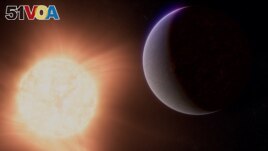11 May 2024
Astronomers have searched for years for rocky planets outside our solar system. They have finally found one with an atmosphere.
Scientists believe that a rocky planet with an atmosphere is key to sustaining life. But the planet that astronomers found offers no hope for life. Its surface is made up of molten rock.
Researchers recently called the planet a "super-Earth." It is a rocky world much larger than our planet but smaller than the gas giant in our solar system, Neptune.

An artist's concept shows the exoplanet 55 Cancri e, also called Janssen, a rocky planet much larger than Earth but smaller than Neptune, along with the star it orbits in this undated illustration released by NASA. (NASA, ESA, CSA, Ralf Crawford (STScI)/Handout via REUTERS)
The planet orbits extremely close to its star. The star is less bright and smaller than our own.
Observations using two devices aboard the James Webb Space Telescope suggest there is an atmosphere. But the atmosphere may not be able to support life. It could be continuously filled up by gases that large areas of molten rock release.
Renyu Hu is a planetary scientist with NASA's Jet Propulsion Laboratory and California Institute of Technology. He was the lead writer of the study, which appeared recently in the publication Nature.
Hu said, "The atmosphere is likely rich in carbon dioxide or carbon monoxide, but can also have other gases such as water vapor and sulfur dioxide." He added that current observations cannot tell what the exact atmospheric makeup is.
The Webb data also did not make clear the thickness of the atmosphere. Hu said it could be as thick as Earth's or even thicker than that of Venus. Venus has a toxic atmosphere that is the densest in our solar system.
The planet is called 55 Cancri e. Scientists also call it Janssen. It is about 8.8 times more massive than Earth and about two times as wide.
It orbits its star at one-25th the distance between our solar system's innermost planet Mercury and the sun. As a result, its surface temperature is about 1,725 degrees Celsius.
One side of the planet probably always faces its star. Four other planets, all gas giants, are known to orbit the same star. The planet is found in our Milky Way galaxy, about 41 light-years from Earth. A light-year is the distance light travels in a year, or 9.5 trillion kilometers.
The planet's star is gravitationally tied to another star in the system. Having two stars in the same system is called a binary system.
The other star is a red dwarf, the smallest kind of an ordinary star. The distance between these two stars is 1,000 times the distance between Earth and the sun. Light from one star takes six days to reach the other star.
Although the rocky planet does appear to have an atmosphere, scientists say it probably should not even have one. Being so close to its star, any atmosphere should be taken away by the effects of the star.
But gases dissolved in the planet's large ocean of molten rock may continue to fill up the atmosphere, Hu said.
"The planet cannot be habitable," Hu added. That is because it is too hot to have liquid water, which is also considered necessary for life.
Scientists have found other planets with an atmosphere outside our solar system. But they have all been gaseous planets, not rocky ones.
As the James Webb telescope pushes the limits of space exploration, the discovery of a rocky planet with an atmosphere is a sign of progress.
On Earth, the atmosphere warms the planet. It contains the oxygen people breathe and protects against the effects of the sun. It also creates the pressure needed for liquid water to remain on the planet's surface.
Brice-Olivier Demory is a scientist at Switzerland's University of Bern's Center for Space and Habitability. He helped write the new study. He said, "On Earth, atmosphere is key for life." He added that the findings create hope that the Webb telescope may one day find cooler planets that could support liquid water on their surface.
"But," he said, "we are not there yet."
I'm Gregory Stachel.
Will Dunham reported this story for Reuters. Gregory Stachel adapted it for VOA Learning English.
____________________________________________
Words in This Story
solar system – n. our sun and the planets that move around it
molten – adj. melted by heat
vapor – n. a substance that is in the form of a gas or that consists of very small drops or particles mixed with the air
giant – adj. very large
galaxy – n. any one of the very large groups of stars that make up the universe
habitable – adj. suitable or fit to live in